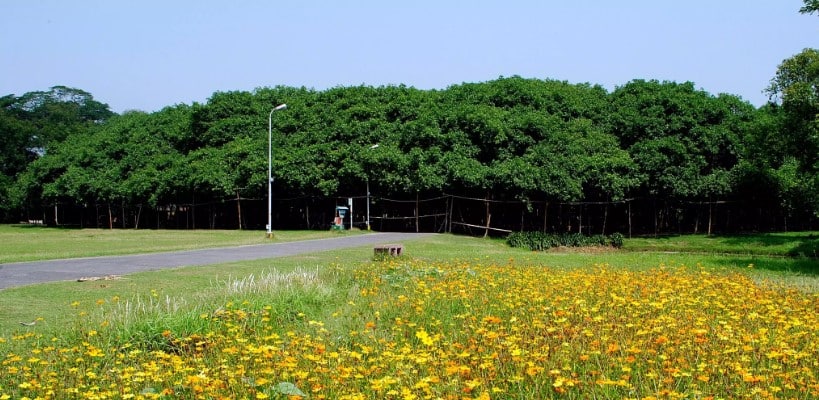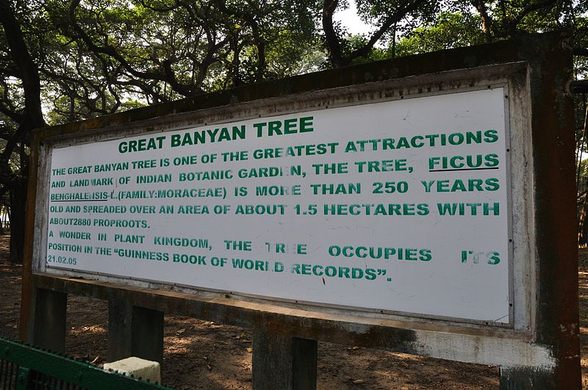Explore The Great Banyan, A Mesmerizing Natural Labyrinth Of Wonder
In the tapestry of India’s diverse cultures and rich heritage, there is a symbol that stands tall and proud – the Great Banyan Tree. This tree embodies the essence of resilience – bending with the winds of adversity yet remaining steadfast in its roots.
As India’s National Tree, this magnificent tree holds a precious place in the hearts of millions of Indians and attracts large numbers of foreign tourists every year. Its grandeur earned it a spot in the Guinness Book of World Records in 1989 as the largest tree of its kind. Join us to learn more about this natural wonder.
1. The history of the garden where the Great Banyan Tree nestled

Nestled within the Acharya Jagadish Chandra Bose Indian Botanic Garden lies the remarkable Great Banyan Tree. This botanical marvel finds its home in a garden with a rich history, once known simply as the Indian Botanic Garden. In 2009, it was renamed to honor the renowned natural scientist Jagdish Chandra Bose.
Back in 1787, Colonel Robert Kyd, an East India Company officer, founded the garden with a clear mission: to cultivate commercially valuable plant species like spices, tea, and teak. At that time, he had no idea that centuries later, the strangler fig, would become the world’s largest banyan tree, captivating visitors with its sprawling canopy and storied past.
2. How big the tree is

The Great Banyan isn’t just any botanical marvel, it’s a towering green giant that leaves visitors in awe, overshadowing even the most exotic flora from five continents.
Spanning an incredible 4.67 acres, equivalent to about the size of a cricket pitch, the sheer magnitude of the Great Banyan’s presence is mind-boggling.
At a height of 80 feet (24.5 metres) and a canopy circumference of 1,594 feet (486 metres), this single tree could easily be mistaken for an entire forest.
3. Challenges faced by the Great Banyan Tree

As the Banyan tree grew outward from its main trunk, it encountered numerous challenges along the way. Despite its resilience, it faced significant damage over the years.
Experts estimate it to be around 250 years old. Throughout its long life, it weathered three devastating cyclones, one in 1864, 1967 and another in 2020. These powerful storms tore through the trunk, leaving the tree vulnerable to fungal attacks. Despite the fungal diseases causing some harm, the Banyan tree displayed remarkable resilience, managing to bounce back from the brink of destruction.
However, the Great Banyan Tree was not quite so lucky when it was struck by lightning in 1925. The powerful strike triggered a fungal infection in the main trunk, leading to its decay. To salvage the tree’s vitality, the affected trunk had to be amputated to save its healthy sections.
At the time of the trunk’s removal, it was more than 50 feet wide. After losing this massive trunk, the Great Banyan Tree displayed remarkable resilience. Through a fascinating process known as clonal colony formation, the tree remained connected through its extensive root system. Even without its central trunk, the tree continued to thrive, perpetuating its legacy through natural genetic cloning.
4. Its unique characteristics

Imagine walking through a colony of trees, but instead of individual trees, you see a multitude of trunks springing up from the ground. However, here’s the fascinating secret: all these trunks are actually part of the same living entity, connected through an underground root system.
In fact, these trunk-like structures aren’t real trunks at all. They are prop roots. These unique roots grow outward from various parts of the tree and then extend into the ground. Over time, they mature and become solid and woody, resembling actual trunks. Currently, the magnificent Great Banyan Tree boasts an astonishing 3,772 aerial roots, and it’s projected to reach a record-breaking 4,000 in the near future.
Today, a 1,083-foot (330 metre) road encircles it while the tree continues to expand beyond these human-made boundaries, defying all limitations.
Despite not even having its trunk, the Great Banyan Tree has become the widest tree on Earth. Its incredible journey includes facing the brink of death, only to rebound with even greater strength and vitality.
5. Its transformation into a global tourist attraction

The Great Banyan Tree’s relentless roots are a constant challenge for local road planners, who struggle to keep up with its expansive growth.
Undeniably, over the years, this botanical marvel has evolved into a must-see attraction, drawing tourists from every corner of the globe to marvel at its magnificence. Thanks to the Indian Botanic Garden’s efforts, visitors can explore the tree’s intricate network of roots and branches, ensuring its accessibility for all who wish to experience its beauty.
A visit to this natural wonder is more than just a stroll through the park—it’s a journey into a captivating labyrinth. Within this maze, lies a hidden treasure: the original trunk, marked by a stone amidst the dense tangle of roots and branches, reminiscent of a fabled treasure waiting to be discovered.

